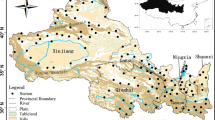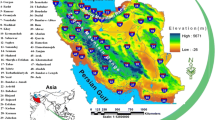Abstract
In this study, in order to detect probable trends and effects of climatic extreme events of precipitation and temperature as well as maximum relative humidity, dew point temperature, sunshine hours, and wind speed, 12 stations on the northern and southern coastlines of Iran were investigated from 1977 to 2007. For this purpose, 27 indices of precipitation and temperature, which are specified by the Expert Team of the World Meteorological Organization and Climate Variability and Predictability, were calculated by using RClimDex software. The Mann–Kendall method was also used to detect possible trends in the data time series. The results indicate that temperature indices are absolutely consistent with warming. Warm nights, hot days, and hot day and night frequencies increased, while cold spell and cool day and night frequencies declined. The minimum temperature experienced a considerable rise both in its maximum and minimum values. The minimum temperature had a higher increase than the maximum temperature. Therefore, diurnal temperature ranges have experienced dramatic declines. In the northern coastal sites, hot day frequency and hottest day temperature showed higher magnitudes than those of the southern sites as a result of the significant increase in the maximum sunshine hours in northern stations. This enhancement led to a considerable increase in the maximum wind speed. Consequently, relative humidity declined in the northern sites. Precipitation indices indicate few significant trends over the studied period. Temporal precipitation distribution was different from station to station. Three precipitation patterns were detected at individual stations, although an overall regional rainfall pattern was not detectable. On the whole, the results of this study emphasize that the water resources in the studied area are going to become problematic.









Similar content being viewed by others
References
Aguilar E et al (2005) Changes in precipitation and temperature extremes in Central America and northern South America, 1961–2003. J Geophys Res 110:D23107. doi:10.1029/2005JD006119
Alexander LV et al (2006) Global observed changes in daily climate extremes of temperature and precipitation. J Geophys Res 111:D05109. doi:10.1029/2005JD006290
Alijani B (2007) Time series analysis of daily rainfall variability and extreme events. 10th International Meeting on Statistical Climatology, Beijing, China
Beersma J, Agnew MD, Viner D, and Hulme M (2000) Climate scenarios for water-related and coastal impacts. Proceedings of the EU Concerted Action Initiative ECLAT-2 Workshop 3, KNMI, Netherlands, Research Unit, Norwich, UK, p 140
Carbajal LR, Pellicciotti F, Molnar P (1993) Analysis of hydro-climatic trends in the Aconcagua River Basin, Central Chile. Institute of Environmental Engineering, ETHZ Zurich, Zurich
Cramer W, Doherty R, Hulme M, and Viner D (2000) Climate scenarios for agricultural and ecosystem impacts. Proceedings of the EU Concerted Action Initiative ECLAT-2 Workshop 2, Potsdam, Germany, Climatic Research Unit, Norwich, UK, p 120
Easterling DR et al (2003) CCI/CLIVAR workshop to develop priority climate indices. Bull Am Meteorol Soc 8:1403–1407
Frei C, Schar C (2001) Detection probability of trends in rare events: theory and application to heavy precipitation in the Alpine region. J Clim 14:1568–1584
Frich P et al (2002) Observed coherent changes in climatic extremes during the second half of the twentieth century. Clim Res 19:193–212
Gallego MC, Garcia JA, Vaquero JM, Mateos VL (2006) Changes in frequency and intensity of daily precipitation over the Iberian Peninsula. J Geophys Res 111:D24105
Groisman PY et al (1999) Changes in the probability of heavy precipitation: important indicators of climatic change. Clim Change 42:243–283
Haylock MR et al (2006) Trends in total and extreme South American rainfall in 1960–2000 and links with sea surface temperature. J Clim 19(8):1490–1512
Hedayat Dezfuly A (2001) Analysis on changes in starting date of precipitation and its trend in Tehran. Research Institute of Meteorology of Tehran, Tehran (in Persian)
Huth R (1999) Testing for trends in data unevenly distributed in time. Theor Appl Climatol 64:151–162
Karl TR, Knight RW (1998) Secular trends of precipitation amount, frequency, and intensity in the United States. Bull Am Meteorol Soc 79:231–241
Karl TR, Nicholls N, Ghazi A (1999a) Weather and climate extremes: changes, variations and a perspective from the insurance industry. Clim Change 42:1–349
Karl TR, Nicholls N, Ghazi A (1999b) CLIVAR/GCOS/WMO workshop on indices and indicators for climate extremes: workshop summary. Clim Change 42:3–7
Karl TR et al (1995) Trends in high-frequency climate variability in the 20th-century. Nature 377:217–220
Kavyani M, Asakereh H (1999) Investigation of Isfahan annual precipitation. Department of Geography, Isfahan and Zanjan University, Zanjan (in Persian)
Kiktev D et al (2003) Comparison of modeled and observed trends in indices of daily climate extremes. J Clim 16:3560–3571
Matondo JI, Msibi KM (2001) Estimation of the impact of climate change on hydrology and water resources in Swaziland. Water Int 26(3):425–434
Manton MJ et al (2001) Trends in extreme daily rainfall and temperature in Southeast Asia and the South Pacific: 1961–1998. Int J Climatol 21:269–284
Meehl GA, Zwiers F, Evans J, Knutson T, Mearns L, Whetton P (2000) Trends in extreme weather and climate events: issues related to modeling extremes in projections of future climate change. Bull Am Meteorol 81:427–436
Moberg A et al (2005) Highly variable Northern Hemisphere temperatures reconstructed from low- and high-resolution proxy data. Nature 433:613–617
Munich Re (2002) Flooding in central and eastern Europe—August 2002. MRNatCatposter 31, available as pdf from www.munichre.com
New M et al (2006) Evidence of trends in daily climate extremes over southern and western Africa. J Geophys Res 111:D14102. doi:10.1029/2005JD006289
Nicholls N et al (1996) Observed climate variability and change. In: Houghton JT (ed) Climate change 1995. The science of climate change. Cambridge Univ. Press, New York, pp 133–192
Osborn TJ et al (2000) Observed trends in the daily intensity of United Kingdom precipitation. Int J Climatol 20:347–364
Peterson TC et al. (2001) Report on the activities of the working group on climate change detection and related rapporteurs 1998–2001. WMO, Rep. WCDMP-47, WMO-TD 1071, Geneva, Switzerland, p 143
Peterson TC (2005a) Climate change indices. WMO Bull 54(2):83–86
Peterson TC (2005) The workshop on enhancing South and Central Asian Climate monitoring and indices. Pune, India, February 14–19, 2005, CLIVAR Exchanges 10(2):6.
Peterson TC et al (2002) Recent changes in climate extremes in the Caribbean region. J Geophys Res 107(D21):4601. doi:10.1029/2002JD002251
Sen Roy S, Balling RC (2004) Trends in extreme daily precipitation indices in India. Int J Climatol 24:457–466
Sneyers R (1990) On the statistical analysis of series of observation. World Meteorological Organization (WMO). Technical note. No. 143, Geneva, p 192
Sohrabi MM (2008) Climate change and it's discrimination in Hamadan Province using precipitation data and GIS application. M.Sc. thesis, Agricultural Faculty, Bu-Ali Sina University, p 90
Sohrabi MM, Marofi S, and Ababaei B (2009) Investigation of temperature and precipitation indices by using RClimDex and R software in Semnan province. International Conference on Water Resources, 16–18 August, pp 341–348
Turkes M, Sumer UM, Demir I (2002) Re-evaluation of trends and changes in mean, maximum and minimum temperatures of Turkey for the period 1929–1999. Int J Climatol 22:947–977
Vincent LA et al (2005) Observed trends in indices of daily temperature extremes in South America 1960–2000. J Clim 18(23):5011–5023
Wang XL (2003) Comments on detection of undocumented change points: a revision of the two-phase regression model. J Clim 16:3383–3385
Xu ZX, Chen YN, Li JY (2004) Impact of climate change on water resources in the Tarim River Basin. Water Resour Manag 18(5):439–458
Yu PS, Yang TC, Wu CK (2002) Impact of climate change on water resources in Southern Taiwan. J Hydrol 260:161–175
Yue S, Hashino M (2003) Long term trends of annual and monthly precipitation in Japan. J Am Water Resour As 39(3):587–596
Author information
Authors and Affiliations
Corresponding author
Rights and permissions
About this article
Cite this article
Marofi, S., Sohrabi, M.M., Mohammadi, K. et al. Investigation of meteorological extreme events over coastal regions of Iran. Theor Appl Climatol 103, 401–412 (2011). https://doi.org/10.1007/s00704-010-0298-3
Received:
Accepted:
Published:
Issue Date:
DOI: https://doi.org/10.1007/s00704-010-0298-3




